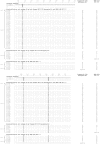Hepatitis C virus (HCV) genotype 1 subtype identification in new HCV drug development and future clinical practice
- PMID: 19997618
- PMCID: PMC2785465
- DOI: 10.1371/journal.pone.0008209
Hepatitis C virus (HCV) genotype 1 subtype identification in new HCV drug development and future clinical practice
Abstract
Background: With the development of new specific inhibitors of hepatitis C virus (HCV) enzymes and functions that may yield different antiviral responses and resistance profiles according to the HCV subtype, correct HCV genotype 1 subtype identification is mandatory in clinical trials for stratification and interpretation purposes and will likely become necessary in future clinical practice. The goal of this study was to identify the appropriate molecular tool(s) for accurate HCV genotype 1 subtype determination.
Methodology/principal findings: A large cohort of 500 treatment-naïve patients eligible for HCV drug trials and infected with either subtype 1a or 1b was studied. Methods based on the sole analysis of the 5' non-coding region (5'NCR) by sequence analysis or reverse hybridization failed to correctly identify HCV subtype 1a in 22.8%-29.5% of cases, and HCV subtype 1b in 9.5%-8.7% of cases. Natural polymorphisms at positions 107, 204 and/or 243 were responsible for mis-subtyping with these methods. A real-time PCR method using genotype- and subtype-specific primers and probes located in both the 5'NCR and the NS5B-coding region failed to correctly identify HCV genotype 1 subtype in approximately 10% of cases. The second-generation line probe assay, a reverse hybridization assay that uses probes targeting both the 5'NCR and core-coding region, correctly identified HCV subtypes 1a and 1b in more than 99% of cases.
Conclusions/significance: In the context of new HCV drug development, HCV genotyping methods based on the exclusive analysis of the 5'NCR should be avoided. The second-generation line probe assay is currently the best commercial assay for determination of HCV genotype 1 subtypes 1a and 1b in clinical trials and practice.
Conflict of interest statement
Figures



References
-
- Simmonds P, Bukh J, Combet C, Deleage G, Enomoto N, et al. Consensus proposals for a unified system of nomenclature of hepatitis C virus genotypes. Hepatology. 2005;42:962–973. - PubMed
-
- Meffre C, Delarocque-Astagneau E, Pioche C, Dubois F, Roudot-Thoraval F, et al. Hepatitis C testing, care and treatment: evolution over ten years in France. Hepatology. 2007;46:625A.
-
- Nainan OV, Alter MJ, Kruszon-Moran D, Gao FX, Xia G, et al. Hepatitis C virus genotypes and viral concentrations in participants of a general population survey in the United States. Gastroenterology. 2006;131:478–484. - PubMed
-
- Wasley A, Alter MJ. Epidemiology of hepatitis C: geographic differences and temporal trends. Semin Liver Dis. 2000;20:1–16. - PubMed
-
- National Institutes of Health Consensus Development Conference Statement: Management of hepatitis C: 2002–June 10–12, 2002. Hepatology. 2002;36(suppl. 1):S3–S20. - PubMed
Publication types
MeSH terms
Substances
LinkOut - more resources
Full Text Sources
Other Literature Sources

